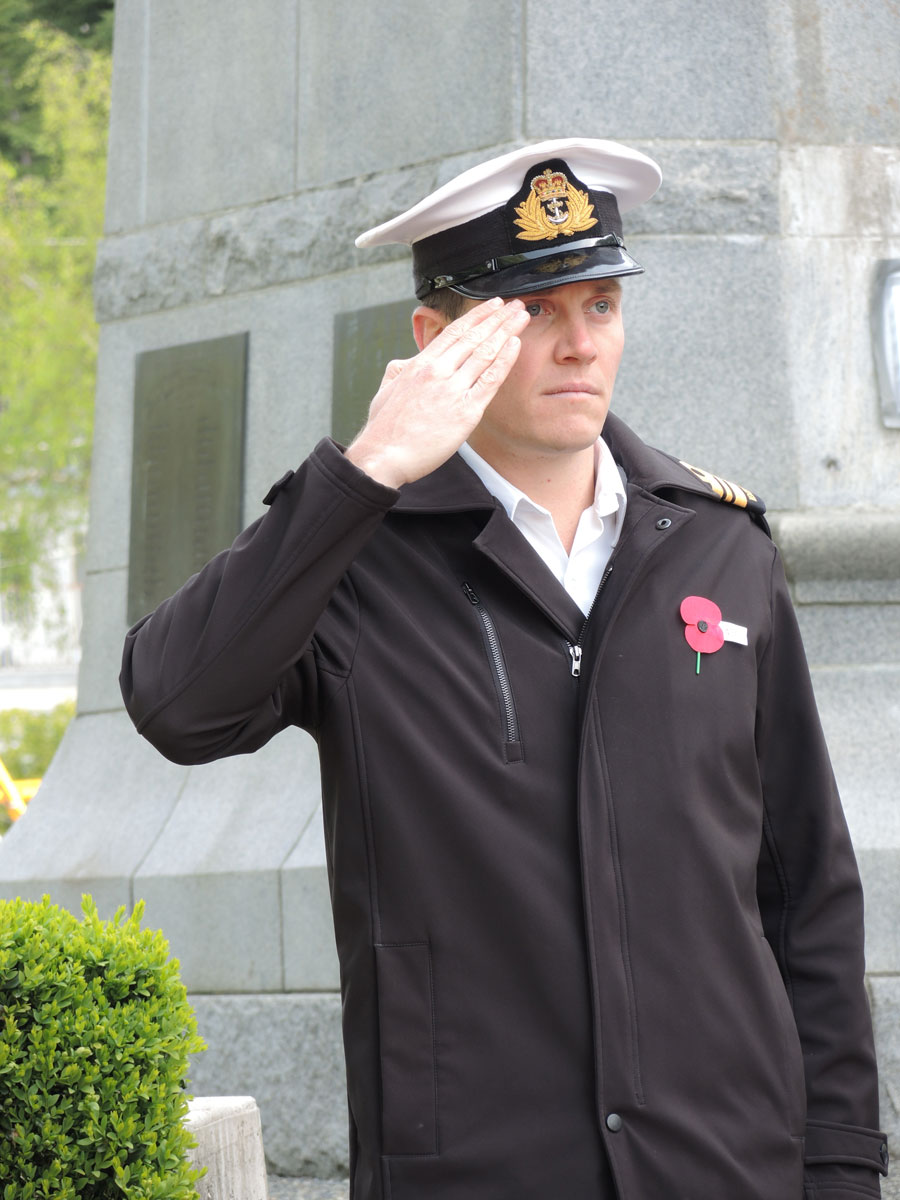New Zealand sailors remember the Battle of River Plate
By Lookout on Apr 30, 2019 with Comments 3

Lieutenant Commander Malcolm Barry, Operations Officer for Royal New Zealand Navy vessel HMNZS Te Mana, salutes during last week’s ANZAC Day ceremony at the Esquimalt Memorial Park Cenotaph.
Peter Mallett, Staff Writer ~
When sailors of the Royal New Zealand Navy (RNZN) gathered to commemorate ANZAC Day last week, the Battle of River Plate was not far from their thoughts.
The decisive battle occurred in the first few months of the Battle of the Atlantic and unfolded off the coast of Uruguay in late 1939. HMS Achilles, a New Zealand-crewed British warship, helped deliver a crushing defeat to Germany and morale-boosting victory for the Allies.
Loaned to New Zealand by the British, Achilles played a pivotal role in disabling Germany’s formidable pocket battleship Graf Spee. Even though Achilles and two Royal Navy ships were heavily outmuscled by the superior German surface raider, Achilles became the first New Zealand warship engaged in a Second World War naval battle, and also their first win.
Last week on April 25, at 10 a.m., approximately 80 RNZN sailors from Her Majesty’s New Zealand Ships (HMNZS) Te Mana and Te Kaha gathered at the cenotaph in Esquimalt to commemorate ANZAC Day.
The national day of remembrance is observed in Australia and New Zealand; it was originally established to commemorate the two nation’s sacrifices of the First World War. Nowadays, ANZAC Day pays homage to military personnel who served in all wars, both conflicts and peacekeeping operations. For sailors of the RNZN, The Battle of River Plate will always be in their thoughts.
Lieutenant Commander Malcolm Barry of Te Mana was one of those who bowed his head in a moment of silence to remember his countrymen who sacrificed so much. LCdr Barry says his thoughts drifted to his Great Grandfathers who fought in the First World War, and to Achilles triumphant moment at River Plate.
“The Battle of River Plate is a huge source of pride for the Royal New Zealand Navy. It was probably one of the highest profile naval engagements that our nation fought at that time.”
The Battle of River Plate
In the opening months of the Battle of the Atlantic, no fewer than eight naval task forces had been deployed by the Allies to seek out and destroy Graf Spee following its sinking of eight merchant ships in the waters of the Indian Ocean and South Atlantic.
Germany’s plan to disrupt commerce and tactically weaken the Allies naval efforts in the southern portion of the Atlantic was all going according to plan with Graf Spee and its commanding officer Captain Hans Langsdorff.
But things changed on Dec. 13, 1939, when Capt Langsdorff sailed Graf Spee into the waters near the estuary of Río de la Plata, also known as River Plate, and into the British Admiralty hunting group of Royal Navy ships HMS Exeter, HMS Ajax, and HMS Achilles.
There were 321 New Zealanders in the Leander-class light cruiser when the engagement with Graf Spee began. A cry from the captain of “Make way for the digger Ensign” echoed across the deck of Achilles, and the New Zealand National flag was raised.
The battle began at 6:20 a.m. and a fierce exchange of shells and torpedoes and ensued for over 80 minutes. A shell fired at Achilles control tower killed four and seriously wounded three others. Exeter took extensive damage with 61 of its members killed and 23 wounded in multiple strikes early on in the exchange.
But Graf Spree was eventually severely disabled by the continued persistence of Achilles and Ajax. It limped into the neutral port of Montevideo and then made an ill-fated attempt to make repairs. A British blockade around the port city was the deciding factor for Langsdorff to scuttle Graf Spee. Days later he committed suicide in his hotel room.
In all, a total of 108 sailors died in the battle – 36 German and 72 Allies.
In the years following the war, the RNZN has done much to celebrate the legacy of Achilles. Its ‘Y’ turret is on display at the main entrance of administrative buildings in Devonport Naval Base in Auckland, serving as a memorial to all who served aboard.
In 2014, a commemorative 75th anniversary parade with 582 Royal Navy sailors, 100 sea cadets, and the family members of veterans took place in Auckland and was meant to recreate the HMS Achilles homecoming parade in 1940.
“The RNZN community is doing much to keep the awareness of this battle alive and at the forefront of people’s minds because as time goes by important moments like this are sometimes forgotten,” said LCdr Barry.
For more information about The Battle of The River Plate visit New Zealand’s website for culture and heritage: https://mch.govt.nz/news-events/news/battle-river-plate-75th-anniversary
Filed Under: Top Stories
About the Author:






My grandfather – Richard Sidney Coleman – served on Achilles during the battle. He was killed in X turret at Guadalcanal.
I am trying to find out anything I can about his life. Thank you. Paul Wood
Greetings and good wishes from Commodore Harwood’s family to LCdr Barry and all those celebrating ANZAC Day who have the River Plate in their thoughts.
Congratulations on this article which well-reflects the Battle and the contribution by Commonwealth navies. On 13 December this year, the anniversary will be remembered in Portsmouth by descendants of the Harwood (naval commander) and Millington-Drake (diplomatic lead) families.